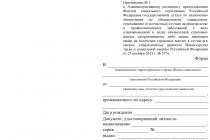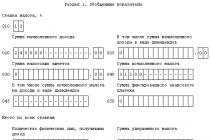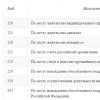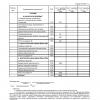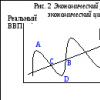Any enterprise in the structure of current assets has accounts receivable, the size of which is often impressive. Competition and the desire to increase the volume of sales of products are forced to use a commodity (commercial) loan, that is, to sell their products with a deferred payment. However, an excessive desire to expand the sales market using this method of sales can provoke an uncontrolled increase in receivables and a decrease in liquidity. At the same time, the enterprise itself runs the risk of becoming insolvent due to a shortage Money. After all, he has his own obligations to suppliers of goods and services.
For a company, provision of interest-free commodity credit buyers is justified only when the benefit from sales with deferred payment will be at least as much as the cost of such a loan. Controlling and managing receivables can relieve a company of these problems, and thus increase economic viability in a complex business world.
By itself, accounts receivable has not only negative aspects, but also positive ones. Its presence indicates the attractiveness and competitiveness of products, allows you to attract buyers, including those experiencing financial difficulties. However, the shortage of funds, diversion financial resources businesses and the risk of bad receivables far outweigh this scale.
The main task of managers is to build such a decision-making system that would allow to evaluate and compare the benefits and risks when concluding transactions with deferred payment. Therefore, in order to achieve the optimal amount of accounts receivable and ensure its timely repayment, a credit policy is developed and regularly reviewed. The credit policy should correspond to the development strategy of the enterprise and implies the solution of the main issues: which counterparties can be granted a commodity loan, and which are undesirable; under what conditions and for how long such a loan is provided; What is the procedure for the withdrawal of receivables.
Elements of the credit policy structure
The structure of the credit policy can be summarized as follows:
1. The purpose of the credit policy and its type.
2. Criteria for evaluating buyers and compiling a credit rating.
3. The maximum amount and terms of granting a trade credit, as well as the size of the discount (depending on the rating of the buyer).
4. Interaction of departments involved in the process of managing receivables, and functions of employees.
5. Applications with forms of documents required in the process of managing receivables.
Let us consider in more detail each element of the structure of the credit policy.
The purpose of the credit policy should be consistent with the development strategy of the company. As a rule, the goal may be to increase the volume of sales and profitability of the company's assets while reducing the risk of insolvency. The objective of a credit policy may be to build strong long-term relationships with buyers and to withdraw debt in a way that does not threaten those relationships.
Note! It is necessary to choose the type of credit policy depending on the rigidity of the parameters of lending and debt collection: aggressive, conservative and moderate.
To do this, it is necessary to constantly compare the expected benefits from the growth in sales volumes and the cost of commercial loans provided, not forgetting the risks of insolvency.
It is important!Often, buyers do not have the opportunity to pay for the goods or the entire volume of purchases in a timely manner, therefore, when concluding a transaction credit conditions must be set individually for each of them. To do this, the criteria and procedure for evaluating buyers to assign them a credit rating are determined..
The terms and sizes of allowable loan amounts for each category of customers will depend on it. In addition, the credit policy should define the size and procedure for determining the total limit of receivables of the enterprise. The easiest way is to study financial statements and juristic documents counterparty to evaluate it financial condition, as well as the dynamics of development and the degree of reliability as a buyer. This is done, for example, commercial banks who analyze entrepreneurial activity client before issuing a loan. Useful liquidity ratios business activity and capital structure indicators. However, the counterparty may refuse to provide financial statements, which should raise doubts about the advisability of granting him a trade credit. After all, the receivables that appeared when working with such a buyer can become hopeless. Intending to study the financial statements, it should be remembered that it can not always give a true and clear picture. Therefore, it will not be superfluous to involve your own security service (if any) in this work and collect additional information regarding the counterparty:
about real owners;
the presence or absence of problems in the field of taxation;
presence or absence of litigation;
about credit history and history of business, foreign economic activity;
branches, representative offices and subsidiaries.
If the company does not have the appropriate service, then with a large scale of the upcoming transaction, it makes sense to seek the services of special agencies to collect information about the counterparty. Attention should be paid to the quality of information, excluding "information noise", and its value.
Then, the selection of criteria is made by which the creditworthiness of future partners will be assessed (for example, the total time of work with this buyer and the volume of transactions with him; positive feedback other organizations that are counterparties of this buyer; stability of fulfillment of obligations in previous periods; turnover of receivables; size and timing of overdue receivables; financial condition of the buyer).
Note!The enterprise independently determines the indicators that are significant for it and the weight of each of them, while the total number of weights should be 100%. The selection of the most significant evaluation criteria and the determination of their weights can be made collegially by the participants in the process (up to the level of the board of directors) or by the person responsible for this process, after receiving the appropriate approvals.
The selected criteria are evaluated on a 100-point scale by the analytical department or loan officer. For this purpose, it is necessary to develop a clear procedure in advance with standards for grading. Moreover, it is necessary to determine the minimum threshold of the result. If the rating score is below this minimum, then this counterparty is recognized as unreliable.
EXAMPLE 1
For clarity, we give an approximate calculation of the rating of the buyer, presented in Table. one.
|
No. p / p |
Criterion |
Specific weight of the criterion, % |
Estimated value for this counterparty |
Result (group 3 × group 4) |
|
Total time spent with this buyer and the volume of transactions with him |
||||
|
The presence of positive feedback from other organizations that are counterparties of this buyer |
||||
|
Stability of fulfillment of obligations in previous periods |
||||
|
Accounts receivable turnover |
||||
|
Sizes and terms of overdue receivables |
||||
|
Buyer's financial condition |
||||
|
Total |
||||
If the minimum threshold for the credit rating and reliability of the counterparty was set, for example, at 50 points, then the data from Table. 1 show that the presented potential buyer scored 64 points as a result of the assessment and the analytical service can give a positive recommendation for working with this enterprise. For greater convenience, you can distribute counterparties into groups depending on the results of the assessment, for example:
- group I: 75 points or more - credit is provided to buyers for general conditions, maximum delays and other individual conditions in case of special significance of a particular buyer or expected benefits in the future;
- group II: from 50 to 75 points - a loan limited in amount or deferred payment can be provided, followed by strict control of the payment term;
- group III: less than 50 points - credit is not provided to buyers.
The next step will be to develop the conditions for granting a commercial loan for each credit rating. To begin with, it is necessary to calculate the minimum allowable rating (P min) of a particular buyer, upon reaching which he will not be denied a commodity loan, according to the following formula:
P min \u003d C × (1 + (D × t/ 365)) / About procurement,
where C is the cost of the purchased volume of products;
D - percentage alternative income(for example, granting a loan to another enterprise at this rate);
t- term of the loan;
О purchases - the volume of the proposed purchase by the counterparty.
EXAMPLE 2
The buyer intends to buy products for a total amount of 330,000 rubles. The cost of this volume of goods is 259,000 rubles. The enterprise could receive an opportunity income at the rate of 11%. The loan is provided for 40 days. Then the minimum credit rating the buyer will be: P min \u003d 0.79, or 79 points (259,000× (1 + (0,11 × 40 / 365)) / 330 000).
As you can see, under these conditions, it makes sense to sell products on credit to this buyer if his credit rating is 79 or more points (otherwise, a transaction under such conditions is unprofitable).
The acceptable term of commercial credit most often depends on the amount of discounts applied for early payment of products. You can calculate the allowable discount using the following formula:
Discount = D / (D + 365 / ( t - t sk)),
where t sk — validity period of the discount.
EXAMPLE 3
Let's determine the amount of a possible discount if its validity period is 5 days. The loan term and the percentage of alternative income (we use the data of example 1) are 40 days and 11%, respectively.
Discount = 0.11 / (0.11 + 365 / (40 - 5)) = 0.01, or 1%.
Under these lending conditions, a discount of 1% would be optimal.
Note! To stimulate the interest of buyers in prepayment or in the timely repayment of receivables, an enterprise can develop attractive discount systems, ranging from the largest for 100% prepayment and ending with various discounts for the purchase volume, for timely or early payment.
There are also possible options for applying the system of accrual of penalties and fines for late payment according to the debt repayment schedule, which should be reflected in the contract. But they need to be introduced deliberately, especially in the case of minor violations, so that this does not negatively affect relationships with counterparties and, ultimately, the company's turnover.
An important part in the structure of the credit policy is the regulation of the interaction of departments involved in the process of managing receivables, as well as the delineation of functions and responsibilities of the employees involved. This section of the credit policy serves to reduce decision-making time and establish a unified scheme of interaction in certain situations. Often at enterprises these tasks are performed by separate documents - regulations, procedures or instructions. As a rule, you need to cover the activities of many services (security services, financial, legal, commercial, marketing, etc.). It would be useful to motivate employees by bonuses or the use of increasing coefficients for salaries, which are dependent on the level of receivables or on compliance with the terms of their repayment.
It is important! The bonus system must be balanced with a system of punishments (remarks, warnings, reduction or deprivation of the bonus). But it is necessary to fine not for the appearance of overdue receivables, but for violation of procedures receivables management (for example, for errors in the calculation of interest, for the supply of products with a ban on shipment this client, distortion of information about the counterparty, non-compliance with the rules of document circulation, etc.).
In the process of managing accounts receivable, various internal documents cannot be dispensed with. The forms of these documents will become part of the credit policy and will be approved along with it. It will help to formalize the process of controlling receivables, for example, a report on settlements with debtors (Table 2), reflecting the timeliness of repayment of receivables in accordance with the terms of contracts. This report is completed weekly or ten days.
Table 2. Report on settlements with debtors
Using the generally accepted classification, accounts receivable should be analyzed by limitation period: current (operational), long-term; overdue; hopeless. A detailed distribution of debt by maturity and for each debtor can be tracked in the register of aging of receivables (Table 3). Monitoring the status of debt on this report should be done once or twice a month. The distribution by terms of payment is carried out on the basis of the company's policy in the field of crediting counterparties. That is, if the management of the enterprise considers a 15-day delay in payment to be acceptable, a debt exceeding this period is the basis for intensifying work with the counterparty, and a delay of more than 60 days is a reason for going to court, then the form of the receivables aging register will reflect this particular grouping of receivables. debt.
Table 3. Register of aging receivables
|
No. p / p |
counterparty |
Term of accounts receivable |
The total amount of debt, thousand rubles. |
Share in total volume, % |
||||||||
|
up to 15 days |
15-30 days |
30-60 days |
over 60 days |
|||||||||
|
thousand roubles. |
thousand roubles. |
thousand roubles. |
thousand roubles. |
|||||||||
Analysis of the aging register will allow you to control the change in the percentage of receivables from its total volume within different reporting periods, as well as to evaluate the nominal composition of debtors, which will allow you to see certain trends. After all, a single appearance of a time-tested buyer in the group of overdue receivables may be the result of a banal error or even a technical failure. The constant inclusion of any counterparty in this group signals its “uncleanliness” or financial difficulties. This trend implies either the termination of lending to such a buyer, or a radical revision of the terms of the loan.
Preparation for the development of credit policy
To solve the problems inherent in the credit policy (do not forget that it must be consistent with the company's development strategy), you will need to perform some preparatory steps:
1) to investigate the existing receivables by the timing of occurrence, from the standpoint of payment discipline, by turnover;
2) install maximum size total limit of accounts receivable;
3) establish debt limits for each counterparty, regularly adjusting them taking into account payment discipline and market risks for the activities of these counterparties;
4) plan the level of receivables.
Various indicators will help analyze the level of existing receivables.
The accounts receivable turnover ratio (About DZ) shows how quickly the company receives money from the buyer. Calculation this indicator produced by the formula:
About DZ = Revenue from sales / DZ cf.
Calculating the receivables turnover in days, or middle period collection (And cf), we can find out if the deadlines for receipt of payments are violated, and also determine how long, on average, a delay is granted to the buyer.
And sr = Period (in days) / About DZ
And av = DZ av / Sales on credit per day.
The volume of credit sales per day is determined by dividing the volume of credit sales for the period by the number of days in the period.
In addition, to calculate some of the above indicators, it is necessary to find the average amount of receivables (DZ cf):
DZ av = ( Accounts receivable at the beginning of the period + Accounts receivable at the end of the period) / 2.
After analyzing the actual state of receivables, you can begin to resolve the issue of establishing its total limit at the enterprise and distributing this limit among specific counterparties.
Let's consider the calculation of these coefficients using an example.
EXAMPLE 4
For 90 days, the enterprise received proceeds from the sale of products in the amount of 800 thousand rubles. Accounts receivable at the beginning of the period amounted to 400 thousand rubles, at the end of the period - 590 thousand rubles. The volume of sales planned for the next period is 1 million rubles. (when setting a limit on receivables of no more than 350 thousand rubles).
DZ cf = (400,000 + 590,000) / 2 = 495,000 rubles.
About DZ \u003d 800,000 / 495,000 \u003d 1.62 turns.
And av = 90 / 1.62 = 56 days (or And av = 495,000 / (800,000 / 90) = 56 days).
Planned turnover of receivables: About DZ \u003d 1,000,000 / 350,000 \u003d 2.86 turnover.
Planned collection period: And cf = 90 / 2.86 = 31 days.
Thus, the achievement of the planned parameters in the next period is possible only if the payment delay is reduced to 31 days.
According to various experts, the maximum possible amount of investment in commercial loans and receivables - from 10 to 30%. You can determine the amount of the allowable total limit of receivables (OL DZ) using the formula:
OL DZ = (Planned sales volume for the period / Period (in days)) × t,
where t- term of the loan.
EXAMPLE 5
With a planned sales volume of 1 million rubles for a period of 90 days. with a credit term of 40 days, the accounts receivable budget will be: OL DZ = (1,000,000 / 90)× 40 \u003d 444,444 rubles.
A generalizing indicator in debt management is the coefficient of overdue receivables (K etc. DZ), which is calculated using the following formula:
To pr. DZ \u003d Amount of overdue debt / Total amount of receivables.
It is important! Experts in this field believe that the 20% amount of overdue debt becomes critical for the organization.
Trends in the state of an enterprise's receivables can be analyzed using the diversion factor working capital(K o), calculated for a certain period:
K o \u003d DZ cf / Total value current assets.
The growth of this indicator indicates an increase in the share of accounts receivable in the total volume of current assets. This means that the company's liquidity is declining. There comes a time of choice between increasing sales volume while increasing receivables and maintaining liquidity.
Note! To analyze receivables, indicators such as the ratio of sales on credit to the total sales for the period, the level of bad receivables, etc. are used.
The indicators should be evaluated in dynamics (track them in the context of not only the company's customers, but also the range of products sold). This is due to the fact that the turnover period for different types products are different, so the terms of the refund will be different.
Accounts receivable risks
Accounts receivable for an actively developing enterprise is a normal phenomenon. Complete disposal of it means the termination of the organization. However, according to experts, when the amount of receivables reaches more than 30% of the assets, there is a significant risk to the economic well-being of the enterprise. As long as buyers fulfill their obligations to the company to pay the debt in a timely manner, the threat of its non-repayment fades into the background. But as soon as counterparties (even one) have financial difficulties or the delay in payments is made intentionally, there is immediately cause for concern.
"Freezing" cash in receivables on a huge scale can even lead to bankruptcy.
When there is a firm belief that the overdue receivables cannot be returned, they are classified as uncollectible. The company can resell such debt to a factoring company (for example, a bank) at a significant discount.
Uncollectible receivables that cannot be disposed of are written off as losses. If an enterprise can predict the percentage of non-repayment of receivables fairly accurately, then for reliability management reporting a reserve should be created to cover it, otherwise the non-repayment of the debt may lead to the non-fulfillment of one's own obligations. For its calculation, you can use the statistics of past periods. The amount of deductions to the reserve, most often set as a percentage of the proceeds from sales on credit, should be fixed in accounting policy management accounting.
Note!An insurance instrument can be used to protect against the risk of non-collection of receivables.
Availability insurance policy sharply increases investment attractiveness business. Insurance Company guarantees payment for the obligations of the client in the event of his insolvency. It is necessary to insure the risk of non-fulfillment by the counterparty of its obligations at the stage of signing the contract, since shipments made before the receipt of the insurance policy will not be an insured event.
Many enterprises (despite the frequent misunderstanding among partners) use a personal guarantee when providing a commodity loan to protect against non-payments CEO debtor company or its owner (major shareholder). It is assumed that a person confident in the fulfillment of obligations will not refuse to sign this document.
Conclusion
As you can see, there are no universal recipes for managing accounts receivable. The content of the credit policy of each company will be different, because any company should be guided by the specifics of its activities, the situation in the market segment it occupies, the strategy of its behavior, the availability of resources. Accounts receivable are a company asset and can be seized if not paid tax collection or filed for bankruptcy. But a liquid asset will be only such a debt that can be withdrawn quickly enough. Therefore, the quality of work with receivables must be given Special attention.
No matter how well the credit policy is developed, without monitoring its implementation it is useless to wait for a visible effect. Therefore, the credit process should be strictly regulated, and the forecasting and monitoring of customer solvency should become a continuous activity.
Automation of the process of accounting and withdrawal of receivables, as well as the introduction of a single database throughout the enterprise will greatly simplify the review of the credit history of counterparties. The client’s electronic card must necessarily reflect the established credit limits, terms for granting a loan, payment discipline, etc. The program can be configured so that if the credit limit is exceeded or there is a delay in payment, the counterparty will automatically be blacklisted, and the shipment of products to such a buyer will be suspended until solving billing problems.
Undoubtedly, receivables are a complex management object that requires the adoption of qualified decisions in various areas: financial, legal, marketing. Their implementation will help improve the well-being of business owners.
E. A. Kozhevnikova,
Leading Economist, CJSC Orenburgtransneft
In the process of financial and economic activity, the enterprise constantly needs to make settlements with its counterparties, the budget, tax authorities. When shipping manufactured products or providing certain services, the enterprise, as a rule, does not receive money in payment immediately, i.e. in fact, it lends to buyers. Therefore, during the period from the moment of shipment of products to the moment of receipt of payment, the enterprise's funds are deadened in the form of receivables. The level of receivables is determined by many factors: the type of product, market capacity, the degree of market saturation of a given
products, the terms of the contract, the settlement system adopted at the enterprise, etc. The last factor is especially important for a financial manager.
Thus, accounts receivable are amounts owed by customers to the business. This debt is formed during the sale and turns into cash after a certain time.
The main types of payments for the supplied products are sales for cash and in the form of non-cash payments. A stable economy is dominated by non-cash payments carried out with the help of checks, bills of exchange, etc.
Accounts receivable management involves, first of all, control over the turnover of funds in the calculations. The acceleration of turnover in dynamics is regarded as a positive trend. Of great importance is the selection of potential buyers and the determination of the terms of payment for the goods provided for in the contracts.
The selection of potential buyers is carried out using informal criteria, namely, it takes into account:
Observance of payment discipline in the past;
forward-looking financial opportunities the buyer to pay for the volume of goods requested by him;
level of current solvency;
level of financial stability;
economic and financial conditions enterprise-seller (overstocking, the degree of need for cash, etc.).
The necessary information for the analysis of potential buyers can be obtained from the published financial reporting, from specialized news agencies, from informal sources.
Accounts receivable management includes the following steps:
· definition of credit policy for different groups of buyers and types of products (differentiated approach);
analysis and ranking of buyers depending on the volume of purchases, the proposed terms of delivery and depending on the history credit relations;
· control of settlements with debtors on deferred or overdue debts;
The use of various methods to increase the turnover of receivables;
development of conditions for the sale of goods that provide a guaranteed flow of funds to the enterprise;
· development of the forecast of cash receipts from the debtor.
The main methods of managing receivables are:
1) accounting for orders, execution of relevant documents and establishing the nature of receivables;
2) conducting an ABC analysis of the debtor, that is, highlighting the most significant receivables in group A and B;
3) assessment of the real value of accounts receivable, taking into account inflation;
4) determination of specific amounts of discounts subject to early payment;
5) decrease in accounts receivable by the amount of bad debts;
6) assessment of the possibility of factoring, that is, the sale of receivables.
The level of receivables is influenced by the credit policy developed by the enterprise itself.
Payment for goods by regular customers is usually made on credit, and the terms of the credit depend on many factors. Working out lending policy buyers of its products, the company must decide on the following key issues:
1) term of the loan . Most often, agreements standardized in terms of payment, including the duration of lending, are used, however, deviations from this policy are also possible. When determining in the contract the maximum allowable period of payment for the delivered products, it should be taken into account as legal aspects conclusion of supply contracts, and economic consequences one or another option (in particular, taking into account the impact of inflation);
2) credit standards . By concluding a contract for the supply of products and determining the terms of payment in it, the enterprise can adhere to the criteria of financial stability established by it in relation to buyers. Depending on how creditworthy and reliable the buyer is, the terms of the contract, including those regarding the discount provided, the size of the batch of products, forms of payment, and others, may change;
3) bad debt provisioning system . When concluding contracts, the company, of course, expects timely receipt of payments. However, the options for the appearance of overdue receivables and the complete inability of the buyer to pay off its obligations are not ruled out. Therefore, there is a practice of creating reserves for doubtful debts, which allows, firstly, to form sources to cover losses and, secondly, to have a more realistic description of one's own financial condition. Data on allowances for doubtful debts and actual losses associated with non-payment of receivables should be subject to careful regular analysis;
4) payment collection system . This section of work with debtors involves the development of:
Procedures for interacting with them in case of violation of payment terms;
Criteria values of indicators indicating the significance of violations;
Punishment systems for dishonest contractors;
5) discount system . Previously, emphasis was placed on repressive methods of dealing with unscrupulous debtors; much more effective are incentive methods, which in this case include giving buyers an option to receive a discount from the selling price. In economically developed countries one of the most common is schema type « d/ kpurely n» (d/ k net n) , meaning that:
The buyer receives a discount d (in percent) in case of payment for the goods received within k days from the beginning of the crediting period (for example, from the moment the goods were received or shipped);
Buyer pays full cost goods, if payment is made in the period from (k + 7)th to n-th day of the credit period (hence, by the way, the semantic load of the term net - by the end of the loan period, the buyer is obliged to "clear" his obligations to the supplier);
In case of non-payment within n days, the buyer will be forced to pay an additional fine, the amount of which may vary depending on the moment of payment.
The receivables management system requires constant monitoring of a number of parameters.
These include:
time of circulation of funds invested in receivables;
The structure of debtors according to various criteria;
· applied schemes of settlements with buyers and the possibility of their unification, the scheme of control over the fulfillment by debtors of their obligations;
· scheme of control and principles of reservation of doubtful debts;
a system for taking action against unscrupulous or non-performing buyers, etc.
Decision-making procedures for the mentioned parameters are mostly informal in nature and are developed as the company develops. However, the enterprise must develop receivables management strategy which should be part of financial policy organizations.
In order to maximize cash flow, the company develops a system of contracts with flexible terms of the terms of their form of payment . These conditions include:
1) prepayment. If the contract is concluded with an advance payment, then, as a rule, the contract provides for a discount;
2) transfer for implementation. The company retains ownership of the goods until they are paid for;
3) issuing an interim invoice. This method is used when concluding long-term contracts. This technique contributes to the regular inflow of cash to the enterprise. It consists in invoicing as products are delivered;
4) flexible pricing. Here comes the development of flexible prices, which can:
Be tied to the general inflation index;
Depend on the level of inflation for specific products;
Take into account the actual payment term and profit from alternative investments of funds;
5) bank guarantee. The bank will reimburse the required amount in case of default by the creditor of its obligations.
A contracting strategy should be flexible if:
if full prepayment is not possible, then partial payment should be requested;
It is necessary to introduce a system of discounts, and not scattered discounts on certain types goods;
· in without fail evaluate the impact of discounts on the financial performance of the company;
· set targets, for example, part of sales on credit can be reserved only for regular customers; reserve part of sales in case emergency and in order to enter new markets;
· Establish remuneration of sales staff depending on the level of accounts receivable and its reduction.
It is justified to include a discount clause in the contract if this leads to an increase in sales and an increase in profits. Discounts can be set if the company is experiencing an acute shortage of cash. In this case, even if the overall financial results for a particular transaction will be negative, the introduction of a discount will lead to an increase in cash, but this is acceptable only in the short term.
Ceteris paribus, discounts for early payment of goods lead to a better result than the introduction of penalties for overdue debts.
Accounts receivable control includes the ranking of receivables by the timing of their occurrence. The most common classification provides for the following grouping (in days):
0 – 30; 31 – 60;
61 – 90; 90 – 120;
Other groupings are also possible. In addition, it is necessary to control bad debts in order to form the necessary reserve.
Analysis and control of the level of receivables can be carried out using absolute and relative indicators, considered in dynamics. In particular, of considerable interest is the control over the timely repayment of debts by debtors. To do this, in addition to the indicators of the presence of overdue receivables, given in form No. 5 "Appendix to the balance sheet of the enterprise", you can use the repayment ratio of receivables, which is calculated as the ratio of the average receivables for the main activity (settlements with debtors for goods, works and services ; settlements on promissory notes received; advances issued to suppliers and contractors) to sales proceeds. The value of this indicator depends on the type of contracts prevailing in the enterprise. So, if the main standard contract provides for payment within two weeks from the date of shipment of the goods, then the critical value of the coefficient is 1/26. Thus, if the calculated value of the coefficient exceeds 1/26, we can conclude that the company has problems with its debtors.
The most common ways of influencing debtors in order to repay debts are sending letters, phone calls, personal visits, selling debts to special organizations.
Depending on the size of receivables, the number of settlement documents and debtors, the analysis of its level can be carried out both by a continuous and selective method. General scheme control and analysis, as a rule, includes several stages:
· stage 1 . The critical level of receivables is set; all settlement documents relating to debt exceeding the critical level are subject to mandatory verification;
· stage 2 . A control sample is made from the remaining settlement documents. Various methods are used for this. One of the simplest is the n-percentage test (for example, with n = 10%, every tenth document is checked, selected on some basis, for example, by the time the obligation arose);
· stage 3 . The reality of the amounts of receivables in the selected settlement documents is checked. In particular, letters can be sent to counterparties with a request to confirm the reality of the amount entered in the document or accounted for;
· stage 4 . The significance of the identified errors is assessed. In this case, different criteria can be used.
The question of the eligibility of matching accounts receivable and accounts payable. Here, the positions of an analyst and an accountant can be diametrically opposed: the first allows for the possibility of comparison (in particular, the entire analysis of liquidity and solvency using special coefficients based on such a comparison), the second is not.
It is sometimes believed that receivables can be any, so long as it does not exceed accounts payable, and that the analysis should take into account only
difference between them. This opinion is deeply erroneous, since the company is obliged to repay its accounts payable, regardless of whether it receives debts from its debtors or not. Therefore, when analyzing accounts receivable and accounts payable, it should be considered separately: accounts receivable as funds temporarily withdrawn from circulation, and accounts payable as funds temporarily attracted into circulation.
The flip side of sales growth is almost always an increase in receivables. In the current post-crisis situation, an increase in production and sales is no longer key factor company development. The main indicator of stability is competent control, planning and management of receivables.
At the stage of making a decision on granting a loan to the buyer, the following are of primary importance:
- the term of the agreement for deferred payment (as a rule, standard agreements with a predetermined loan period are used);
- the level of solvency and reliability of the client, with special attention when collecting information is paid not only to open sources, but also to unofficial ones (for example, personal contacts in regulatory and law enforcement agencies);
- creation of a system of reserves in case of bad debts. The most reliable and honest client based on any standard contract is released from liability in the event of force majeure, and although the circumstances force majeure quite rarely they are the real reason for non-payments, they should not be discounted;
- creation of a reliable mechanism for working with problem payers. As a rule, this responsibility is assigned to the enterprise security service. In addition, they are used financial instruments, such as the accrual of interest for each day of delay, including the day of payment, the revision of the terms of the contract as a whole;
- providing a discount, the amount of which is inversely proportional to the term of the loan. Thus, the client becomes interested in repaying the debt as soon as possible.
First, the level and dynamics of debt in the previous period are analyzed using the formula:
Kdz \u003d Z / A,
where Kdz is a coefficient showing the level of involvement of working capital in receivables;
Z - the amount of debt;
A is the total amount of working capital.
An important indicator of the quality of receivables is the rate of circulation of working capital invested in DZ, which is calculated using the following formula:
KO \u003d OR / Z,
where KO - the number of revolutions of the remote sensing in the period under review;
RR - the amount of turnover in the period under review;
After that, the level of bad debt is determined by the formula:
Kpr \u003d Zpr / Z,
where Kpr is a coefficient expressing the level of overdue debt;
Zpr - debt not paid under the contract in the period under review;
Z - the amount of debt in the period under review.
Then the coefficient of efficiency of investment of working capital in receivables is determined:
Edz \u003d Pdz - Zdz - Pdz,
where Edz is the efficiency ratio of invested funds in receivables;
Pdz - profit received due to the sale on contractual terms;
Zdz - costs associated with the implementation of lending (verification, work with debtors, etc.);
Pdz - the amount of financial losses from non-repayment of debts.
Sdz \u003d Or + Ks x (Pdn + Ppr),
where Sdz - the amount of funds invested in receivables;
Op - the planned sales volume on credit;
Kc - the ratio of the cost and price of products;
Pdn - the weighted average of the number of days for which the goods are shipped on credit;
Pdr - the period of delay in payments, days.
When a company cannot invest the necessary funds in receivables, it is necessary to make an adjustment to the planned revenue and profit received from sales in debt.
One of the new methods of debt management is the refinancing of receivables, the main forms of which are factoring, forfeiting, bill accounting.
Of particular interest to the company is factoring as a tool that covers a significant number of supplier risks. In addition, the capital turnover period increases, for a relatively small percentage the company optimizes the structure of finances, and does not incur additional costs for working with problem customers.
One of the key conditions for granting a loan is to determine the duration of the contract. Due to the increase in the term of the contract, sales volume and revenue increase, but the amount of funds that need to be invested in receivables increases, and the company's financial cycle increases. By setting a limit loan agreement all of the above must be taken into account.
Determining for itself the importance of each of the factors, weighing all the potential risks, the company builds its credit policy, which determines credit limit for each individual period.
In combination with the term for which the loan is granted, its cost is of particular importance. Determined by the system of price discounts for immediate settlements for the supply of products. Based on these indicators, the rate of interest for the granted loan is calculated:
Pg \u003d Tss x 360 / Sp,
where Pg - the rate of interest on the loan;
Сс - discount for immediate payment without delay;
Cn - the term of the loan agreement.
A feature of the establishment of the named norm is its binding to interest rate on bank loan. In all situations, it should be lower than in financial institutions. Otherwise, it is more profitable for the counterparty to take a loan from a bank and pay for the delivery on a prepaid basis.
Based on the experience of domestic companies, it is possible to draw up an algorithm that shows the degree of responsibility of each employee in the process of managing receivables. As a rule, the commercial division of the company (sales department) oversees sales and cash receipts, financial service responsible for information and analytical work. The legal service is responsible for the impeccable state of the document flow for problematic shipments (a necessary condition in the event of a lawsuit). If the debt becomes problematic, then the company's security service is connected to the work.
In addition, it is important that the functions of performers when working with a client are not duplicated. Otherwise, there is inconsistency between departments, leading to a decrease in efficiency. Therefore, it is necessary not only to clearly distribute functions between departments, but also to clearly describe their actions at all stages of working with a problem client (see table).
Distribution of functions of performers when working with clients
Receivables management stage | Actions of departments for managing receivables | Responsible department |
| Establishment of the payment term within the scope of the contract | Signing an agreement | CFO |
| Issuing an invoice for payment | Sales department | |
| Shipment of goods and shipment support (issuing invoices, receiving confirmation from the client that the goods have been received in the proper quantity and quality) | Sales department | |
| Reminder of the payment date (three business days before the end of the contract) | Sales department | |
| Control over late payments up to 7 business days | Finding out the reasons for the delay in payment | Sales department |
| Coordination of the repayment schedule for overdue debts | Financial department | |
| Termination of further shipments | Commercial Director | |
| Written notification of the commencement of the application of penalties | CFO | |
| 7 to 30 working days | Accrual of a fine | CFO |
| Daily reminder calls | Sales department | |
| Personal meeting with the head or owner of the debtor's company | Commercial Director, Sales Department | |
| Written Notice of Preparation for Litigation | legal service | |
| 30 to 60 working days | Repeated personal meeting with the head or owner of the debtor's company, taking all possible measures to find a compromise solution | Head of Security, Sales Department |
| Formal complaint (in writing) | legal service | |
| more than 60 working days | Filing a lawsuit | legal service |
An additional incentive that can reduce the number of bad debts is such an unpopular measure as establishing a relationship between bonus payments to sales employees and the state of the total receivables in the company. Despite the fact that in the process of assessing solvency potential client, its reliability, without exception, all divisions of the company take part, it is the specialists of the sales department who are the first link in the chain of beginning contractual relations, they always have more reliable and up-to-date information about the state of the market, the solvency of certain counterparties. It is on the basis of information transmitted by the sales department to other divisions of the company that decisions are made to sign or not to sign agreements for deferred payment.
Equally responsible is the financial department of the company, whose responsibilities include conducting an error-free analysis of the state of the total receivables for the whole company. The systemic errors that can be made in this case are no less dangerous for the company's activities than the occurrence of bad debts due to the collection of incorrect information about potential customers.
Accounting and timely analysis of the state of receivables is currently impossible without the use of special computer programs and automation of accounting cash receipts. This is due to the growth in the volume of shipments, the number of invoices issued and agreements for deferred payment. At the same time, it is possible to analyze not only by counterparties and periods, but also to identify for which particular product groups, in which price segment, hopeless and problem debt. This, in turn, allows you to more accurately assess the risks when deciding whether to sign an agreement with a particular buyer.
In conclusion, we add that in the process of managing receivables, professionalism and a high degree of motivation of the personnel involved in this process are of great importance. Making all required documents confirming the fact of shipment, the assignment of obligations to the counterparty must be fulfilled exactly on time and in a proper manner. Practice knows many examples when the debtor during the trial was released from payments due to the fact that the plaintiff did not submit all the necessary, correctly executed documents confirming the fact of shipment and the provision of a loan.
In modern economic practice, receivables are classified into the following types:
Accounts receivable for goods, works, services;
Accounts receivable for settlements with the budget;
Accounts receivable for settlements with personnel;
Other types of accounts receivable.
Among the listed types, the largest volume of receivables of enterprises falls on the debt of buyers for shipped products. In the total amount of receivables, settlements with buyers account for 80-90%.
Accounts receivable management policy is part of the organization's overall working capital management and marketing policy of optimizing overall size this debt and ensuring its timely collection.
Overall, the costs and benefits of providing trade credit will depend on many factors . The external ones include:
the general state of the economy. The financial capabilities of buyers and their solvency significantly depend on the general state of the economy.
The state of demand for products and market conditions. Ceteris paribus, for firms that compete fiercely in the market and have a small share of sales, the cost curve of unused opportunities will be higher than for monopolist firms with a stable clientele;
The main internal factors are:
Enterprises with surplus production facilities and low variable operating costs, may adopt a more liberal credit policy than businesses operating at full capacity and with small gross margins.
· condition accounting inventory, the existence of an effective system internal control;
Receivables collection policy. The more active the company is in collecting receivables, the smaller its balances and the higher the quality of receivables;
Some factors are difficult to single out only as external or internal, such as: payment discipline of buyers, the term of the loan ( credit period);
Loan term(credit period) characterizes the limiting period, it usually ranges from 30 to 120 days. Factors affecting the duration of the loan: expiration date, consumer demand, costs, profitability and standardization, credit risk, volume of purchases., competition.
Credit standards– minimum financial stability, which customers must have in order to be able to defer payment.
The amount of the loan(credit limit) characterizes the maximum limit of the amount of the buyer's debt on the provided commodity (commercial) or consumer credit.
Payment collection policy, is determined by the degree of loyalty towards customers who delay payments, in terms of granting a loan again and applying penalties for delay in fulfilling obligations.
Another factor affecting the amount of receivables is the chosen type of credit policy of the organization: The conservative type of credit policy of the organization is aimed at minimizing credit risk. The moderate type of credit policy is focused on the average level of credit risk when selling products with deferred payment. The aggressive type of credit policy of the organization is based on the task of maximizing additional profit, regardless of high level credit risk.
Accounts receivable are classified:
- by maturity (short-term - payments are expected within 12 months after the reporting date; long-term - payments are expected more than 12 months after the reporting date);
- according to the degree of possibility of collection (current - debt within the payment terms established by the agreement; doubtful - the maturity date has already been violated, but the company is sure that the funds will be received; bad - debts are unrealistic to collect).
Companies may establish their own classifications of receivables depending on the size of their operations.
How to avoid doubtful and bad debts
There are several ways to prevent or minimize bad debts.
1. Prepayment
If there is a risk of problems with the buyer, it is better to conclude an agreement with him on an advance payment basis. Moreover, the prepayment in this case must be 100%. Then you, as a supplier, will not have problems with debts.
2. Security in the form of a pledge, surety, bank guarantee
3. Counter debt (accounts payable)
When there is a counter-debt, it is possible to ship products relatively calmly without prepayment, without security and other safety nets. If there are accounts payable and accounts receivable arise, it is always possible to cover them by offsetting.
4. Letter of credit
This is a rather exotic option, although undeservedly forgotten. A letter of credit is one of the forms of non-cash payments, the meaning of which is as follows: when both parties to the contract (for example, for deliveries) do not trust each other (that is, the supplier does not trust the buyer, because he is afraid that he will not pay for it, and the buyer is afraid make an advance payment because I am not sure that the supplier will ship the goods), the problem can be solved by a third independent party represented by the bank (issuing bank).
In this case, the bank opens a letter of credit: part of the funds of the buyer's current account are transferred to a special account in this bank, and the buyer within certain period has no right to dispose of this money. The bank then informs the supplier that the money is "reserved" for him in a separate account and this money will be transferred to him as soon as he submits documents confirming the shipment.
Unfortunately, this service is not very popular. Probably because it's not cheap. But from a financial and civil law point of view, this a good option to prevent debt accumulation.
6 methods of internal control of receivables
It must be said right away that there are no universal methods for controlling receivables. Everything is very specific, and much depends on the activities of the enterprise, its scale, the amounts that pass, customers, the market in which the enterprise operates. There are too many factors to consider. However, you can focus on several important criteria.
1. Planned level of receivables
The maximum allowable amount of receivables is determined by calculation. It is expressed in absolute terms and/or as a percentage of revenue.
We are talking about the amount of debt that the company can afford without serious damage to financial and economic activities. This size is best set in a fixed amount, that is, in rubles. Additionally, you can set it as a percentage of revenue.
2. Conditions for granting a deferred payment (loan) to customers
A company may have a specific deadline - 15 or 30 days, for example. But one term cannot be universal for everyone she works with.
If a we are talking about a key or regular client, then for him the period may be longer. After all, he, as a rule, makes large orders and regularly fulfills his obligations.
If appears new client, in which the company is not yet sure, then it makes sense to revise the term downward. A problematic client needs to set either a minimum period, or even insist on an advance payment.
3. Employee motivation
It is desirable to develop a system in which wage employee will depend on the term of the receivable.
4. Procedure for granting deferred payment to customers
The information collected about him plays an important role in making a decision on granting a loan to a client.
You can start by analyzing information from open sources and the information that is requested from buyers. How long have they been on the market? Which of their counterparties can be contacted for feedback? How accurate are they? A lot of valuable information for analysis can be extracted from the company's website.
It is best to personally visit the buyer's office. This will allow you to form an idea of how risky it will be to work with him.
5. Determining the parameters for evaluating the information provided by the client
In this case, it is important to take into account the availability of property, through which it is possible to repay the debt, the size and dynamics of accounts payable, potential financial difficulties and problems with solvency.
6. Distribution of responsibility for the management of receivables between commercial, financial and legal services
It all depends on the scale of the enterprise, but even in a small enterprise it makes sense to determine who is responsible for what in working with receivables, how responsibility is distributed.
From the point of view of logic, the commercial department should be responsible for granting a deferred payment, to exercise control over the current receivables. The area of work of the legal department is doubtful and uncollectible receivables (personal meetings, negotiations, correspondence, claims, statement of claim). Accounting includes accounting, control over registration and write-off of receivables.







